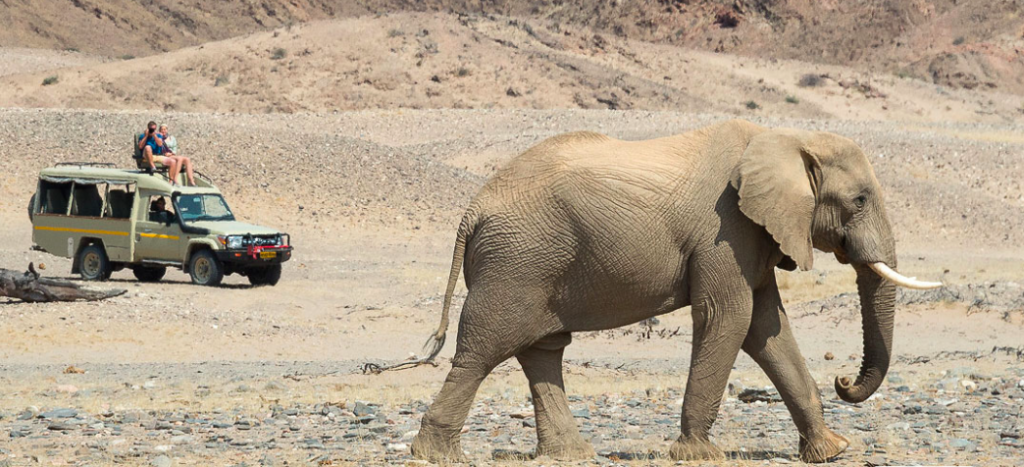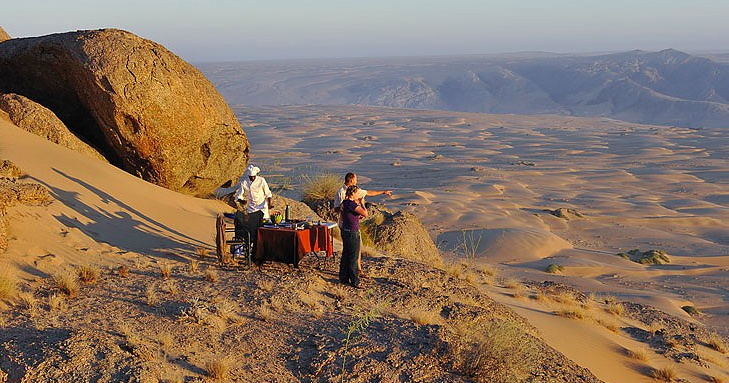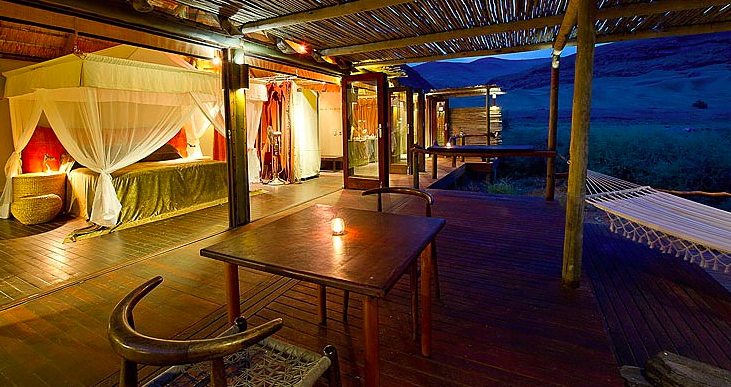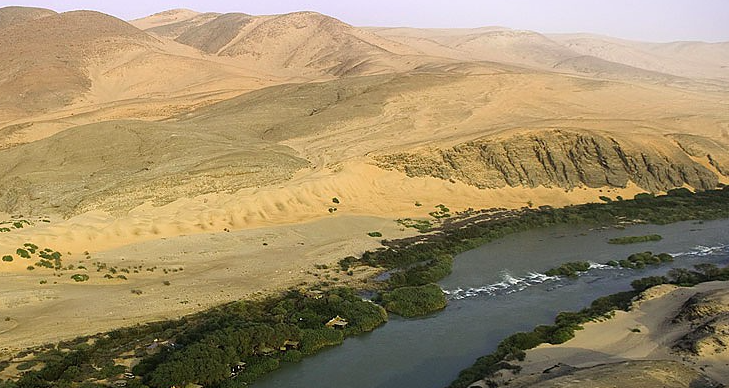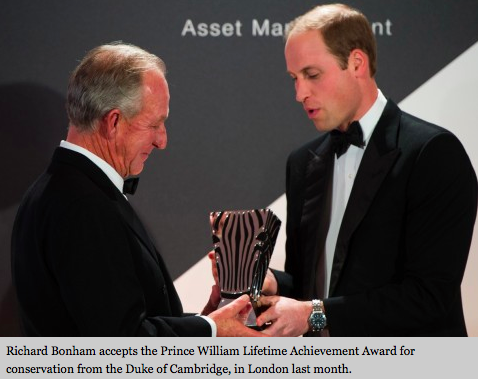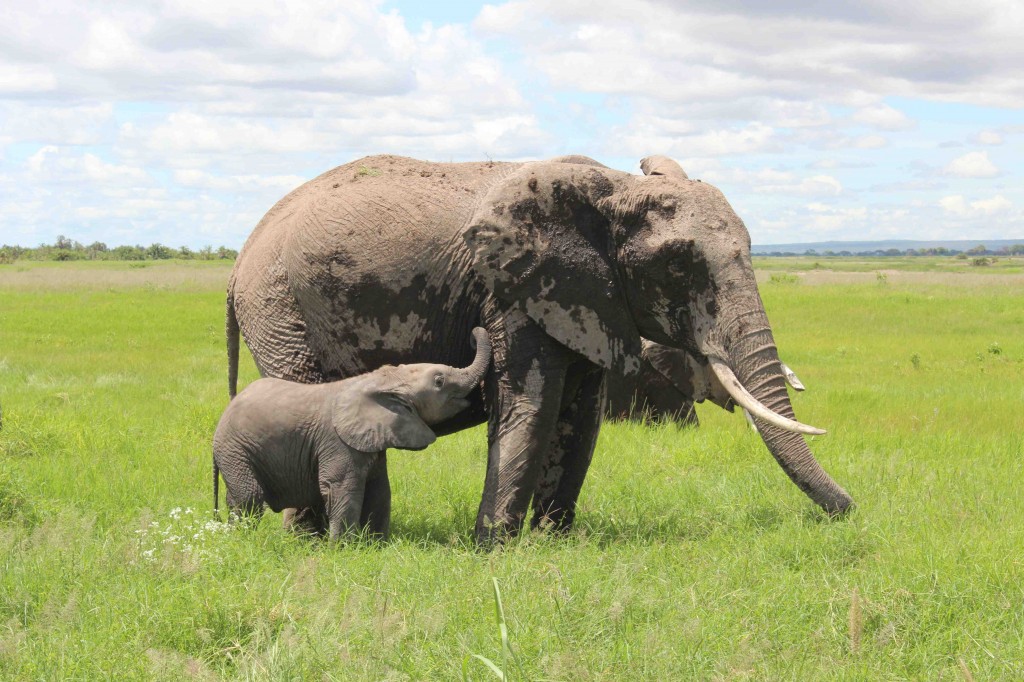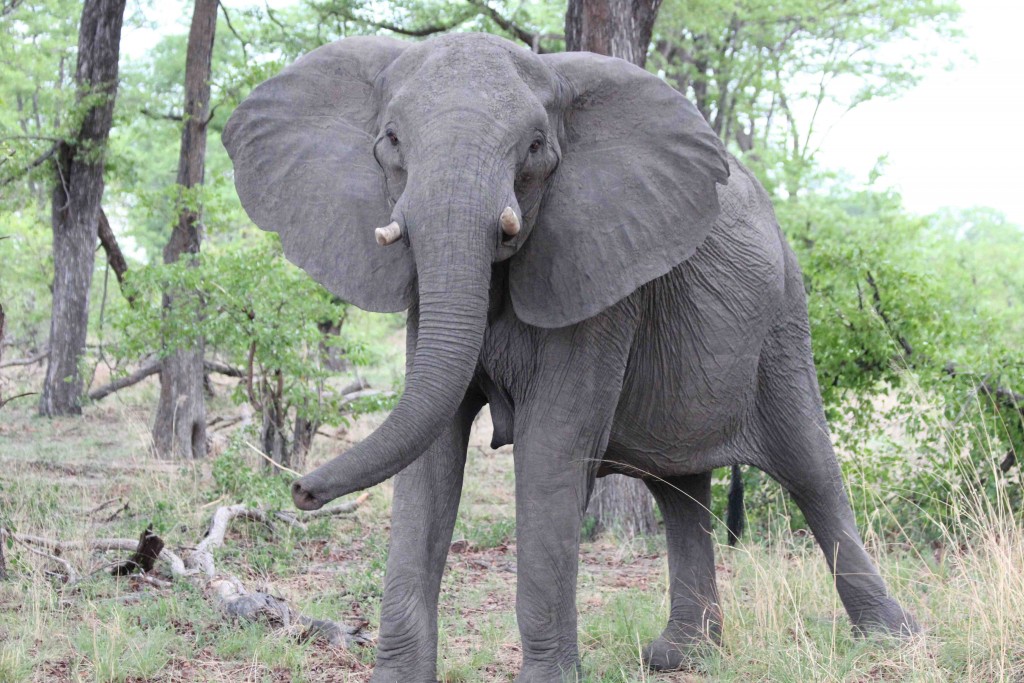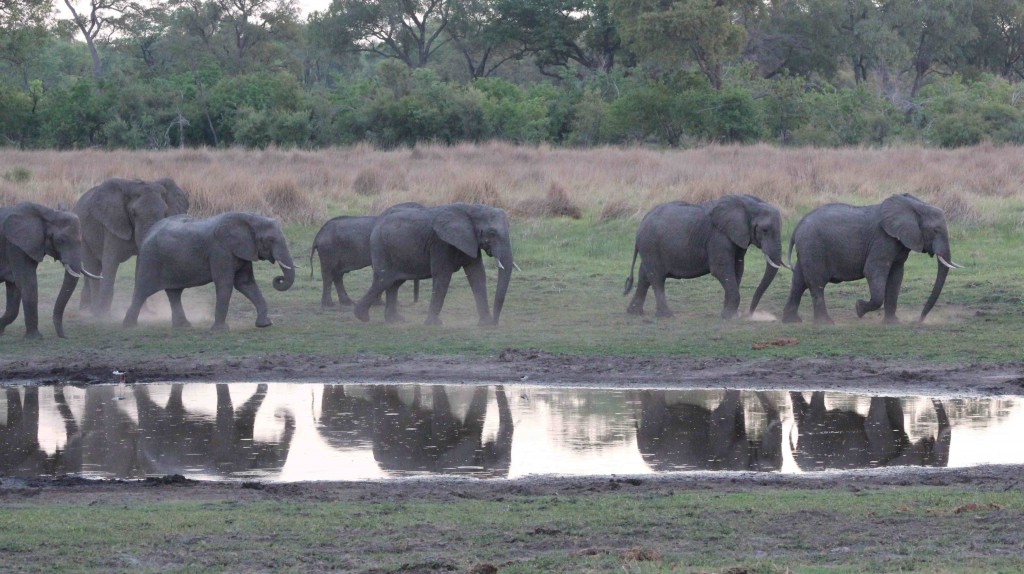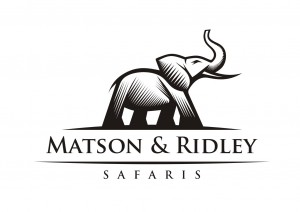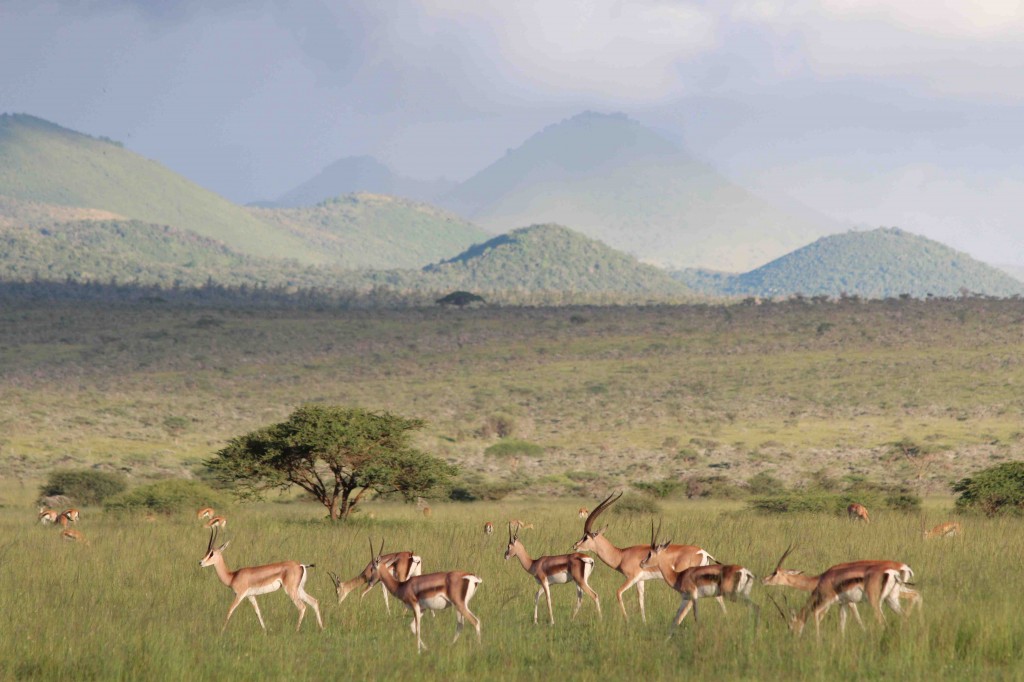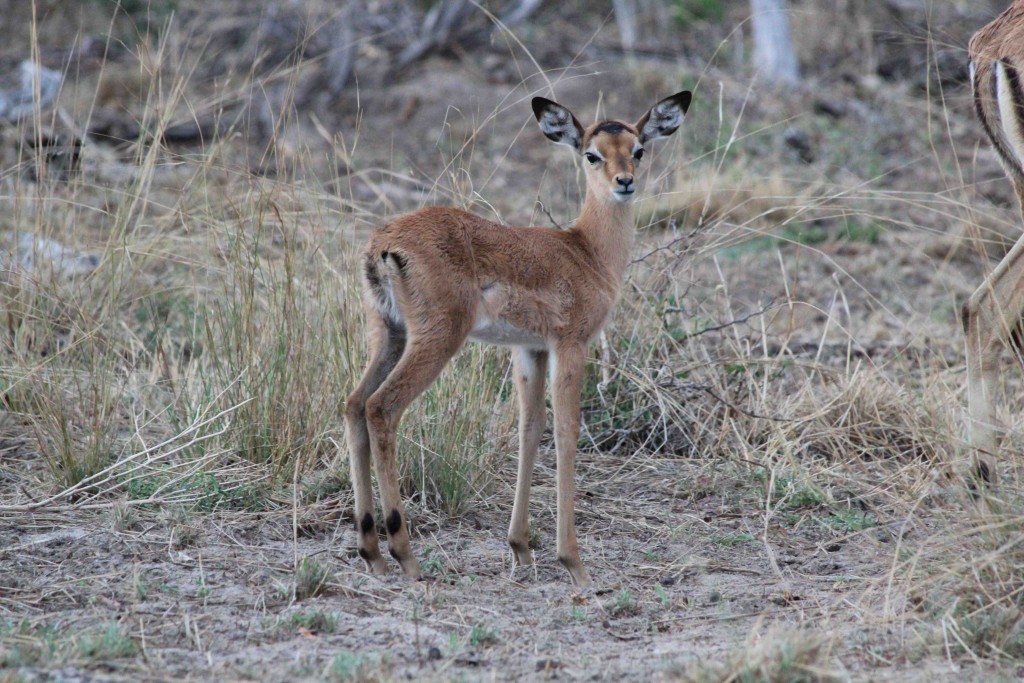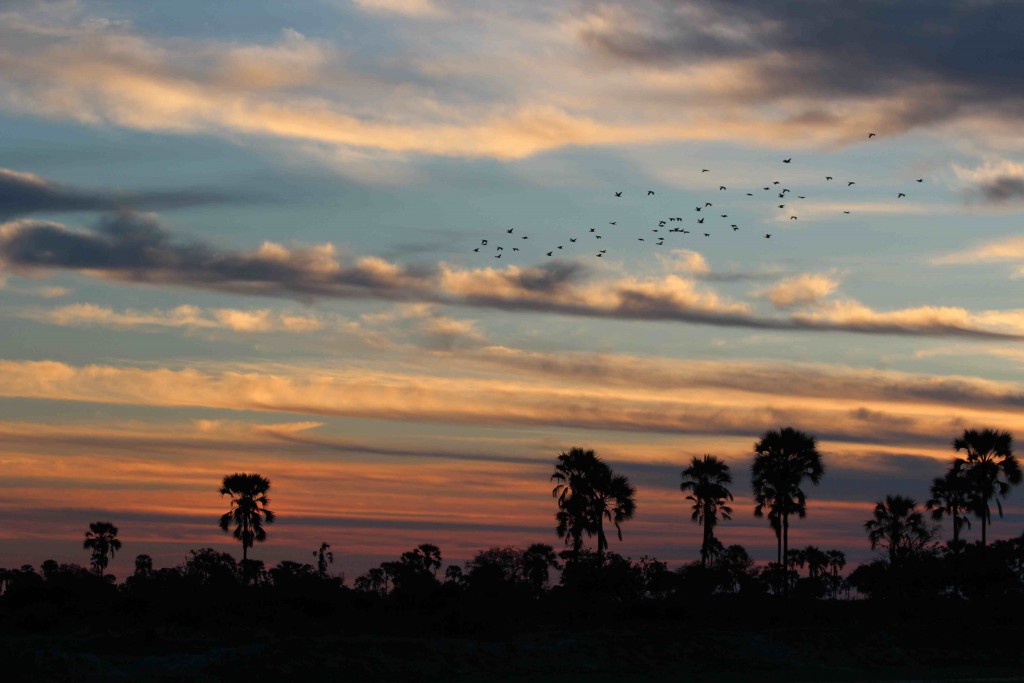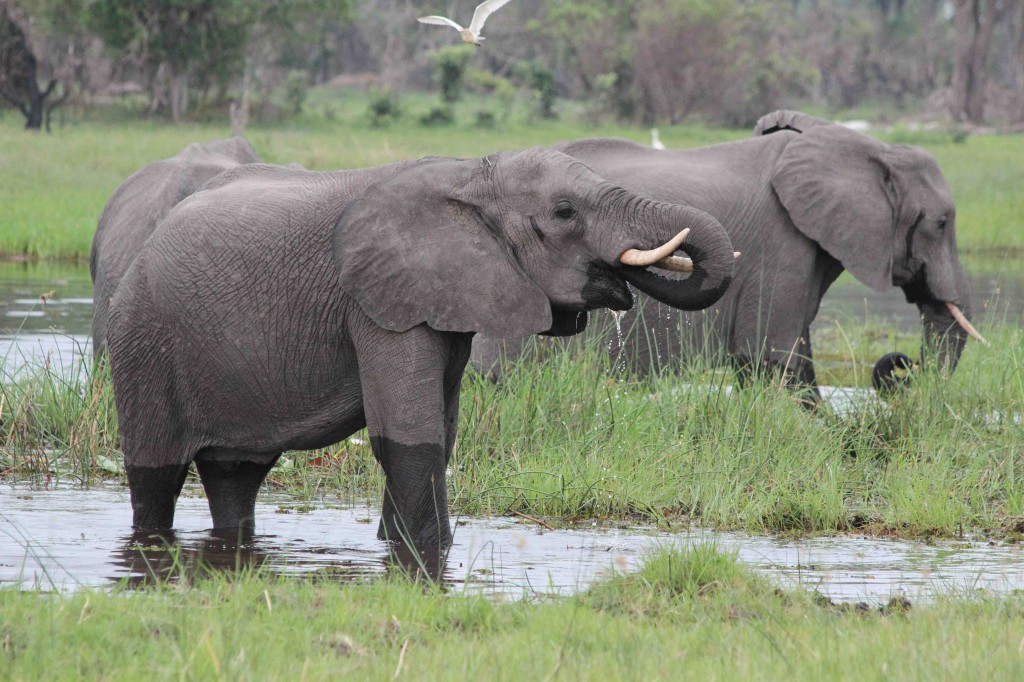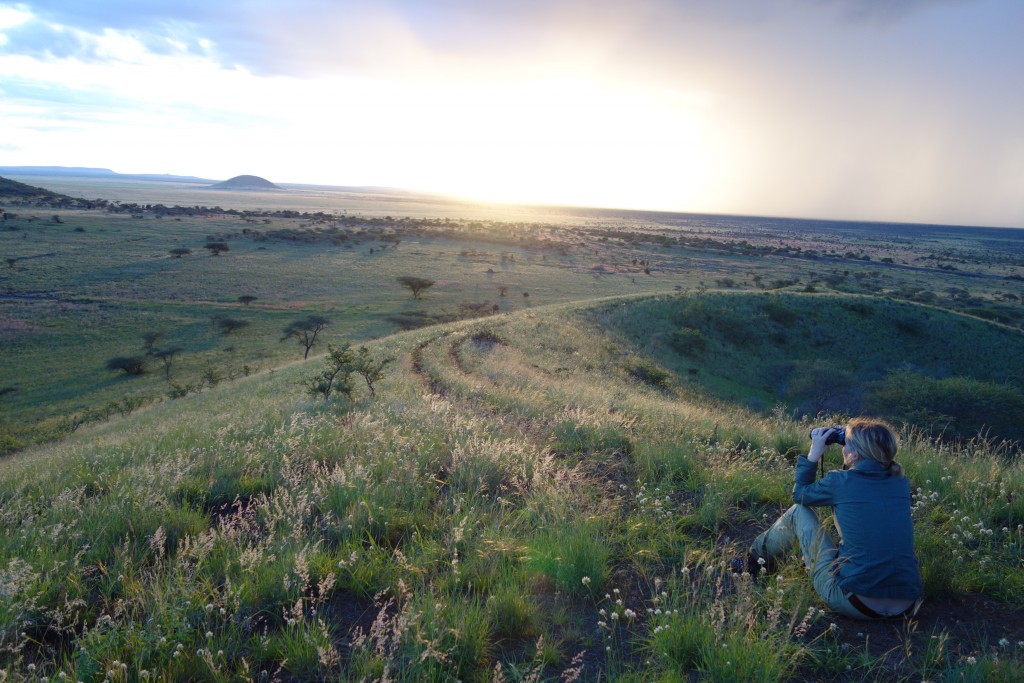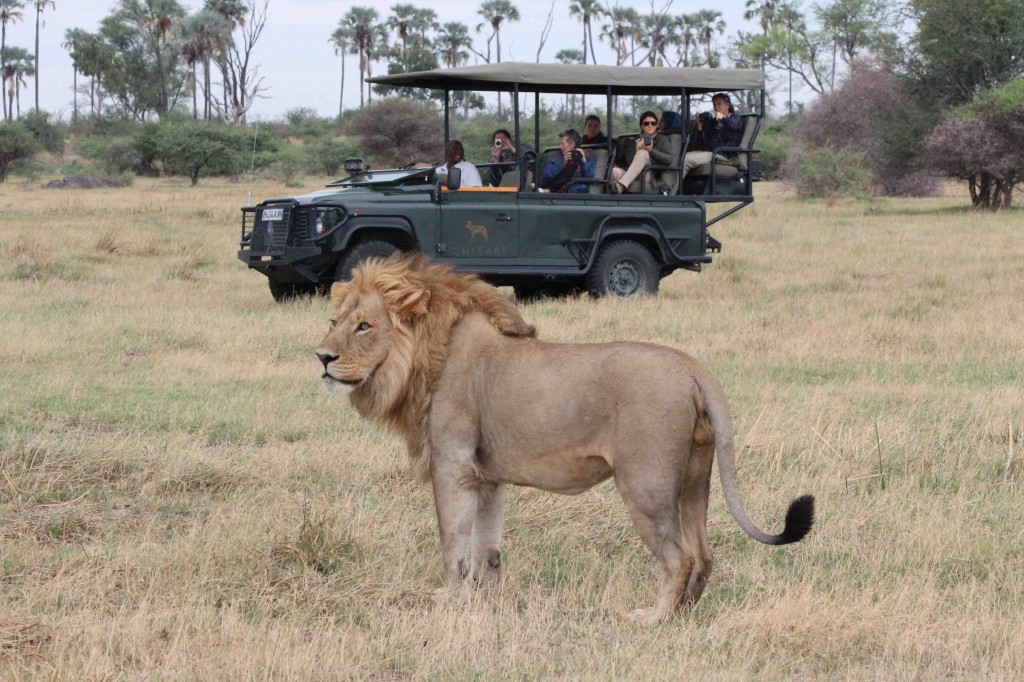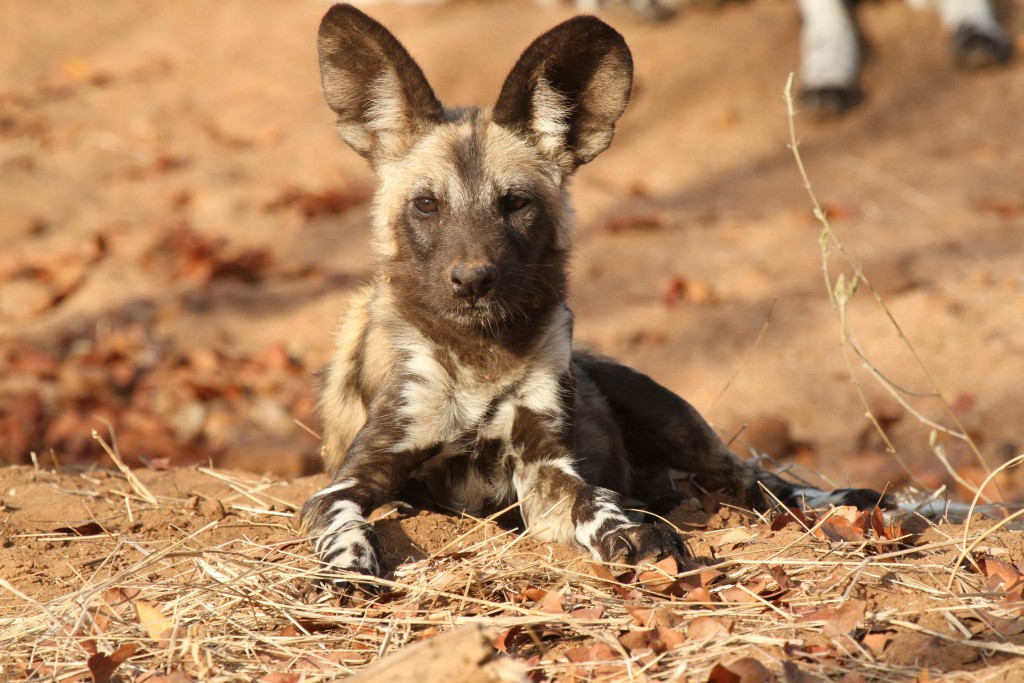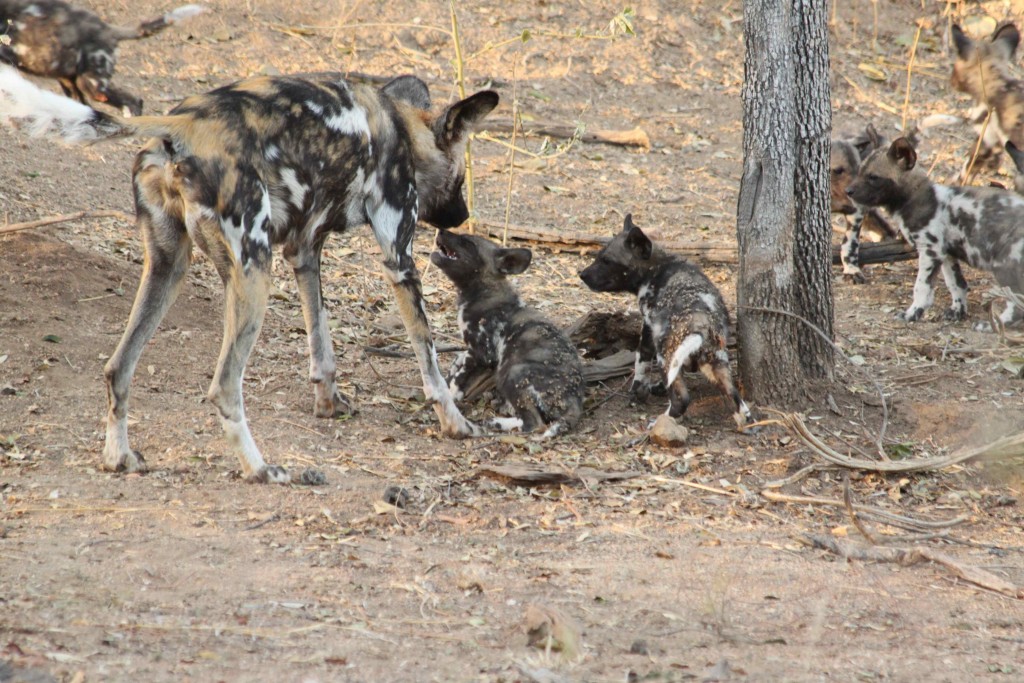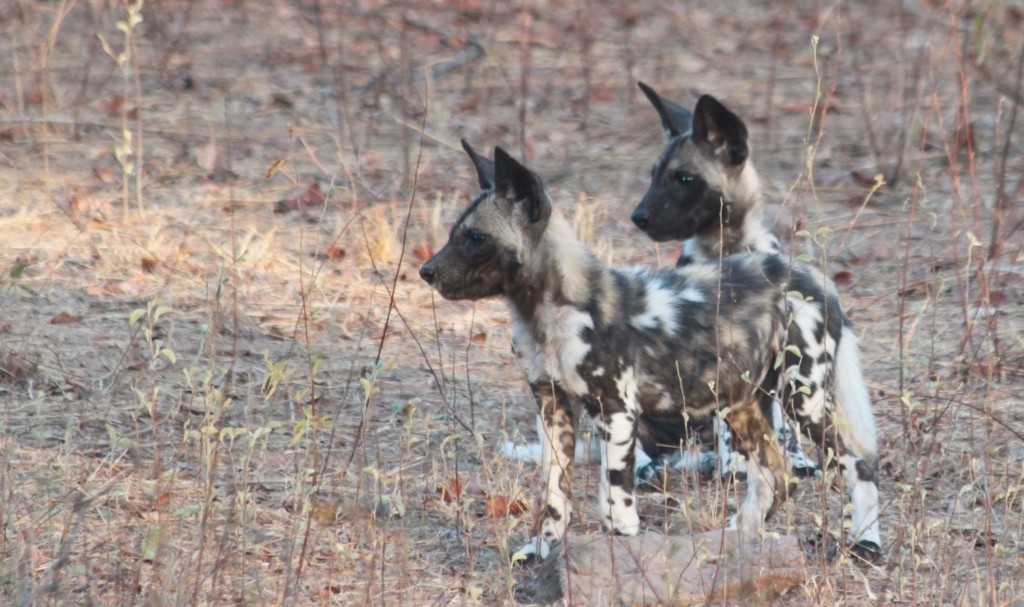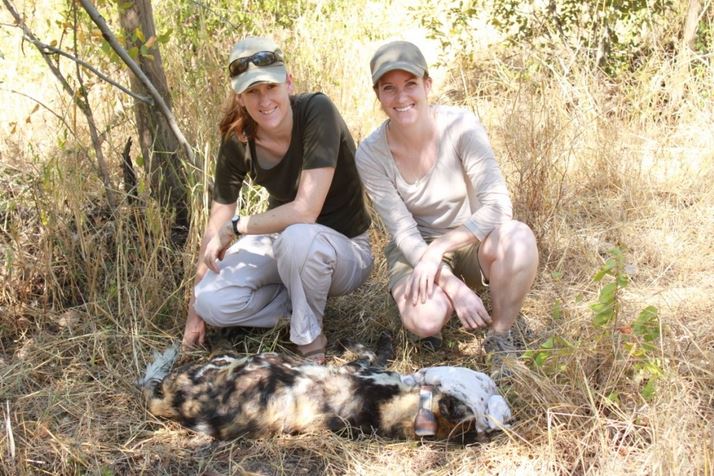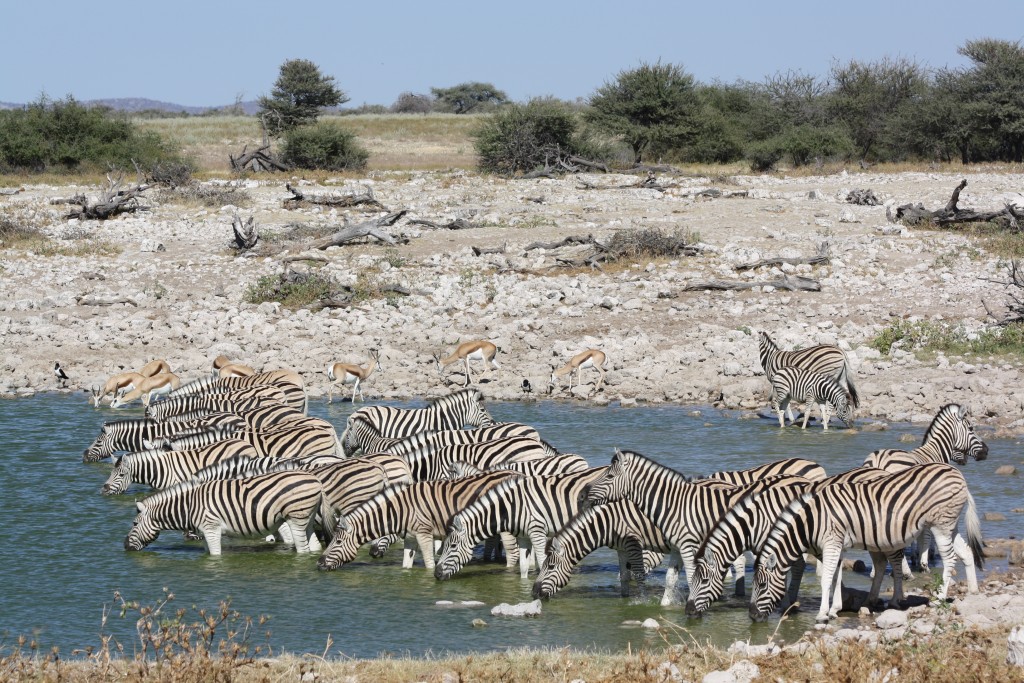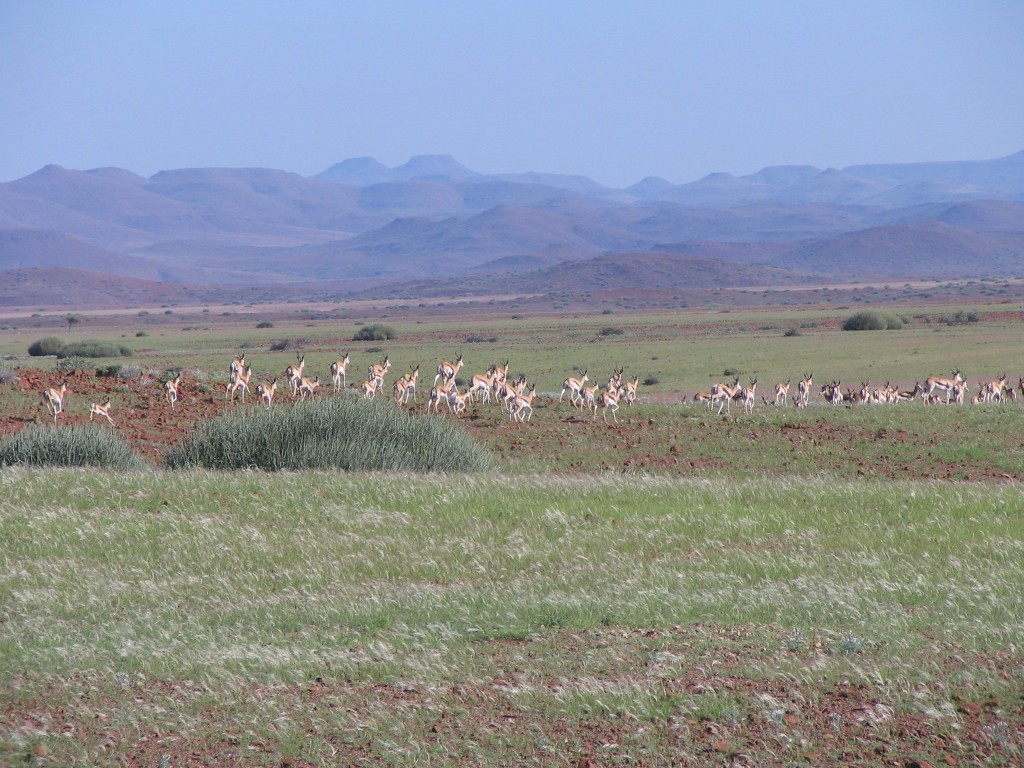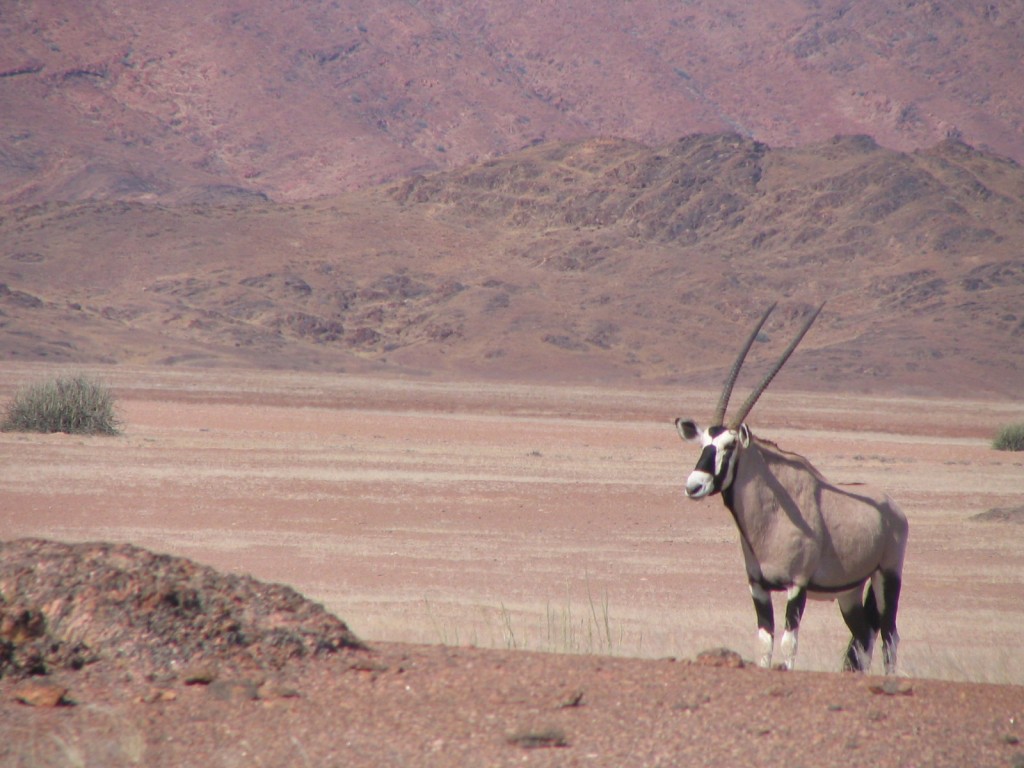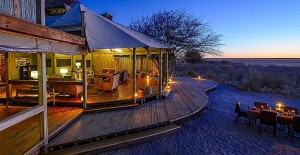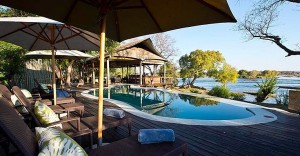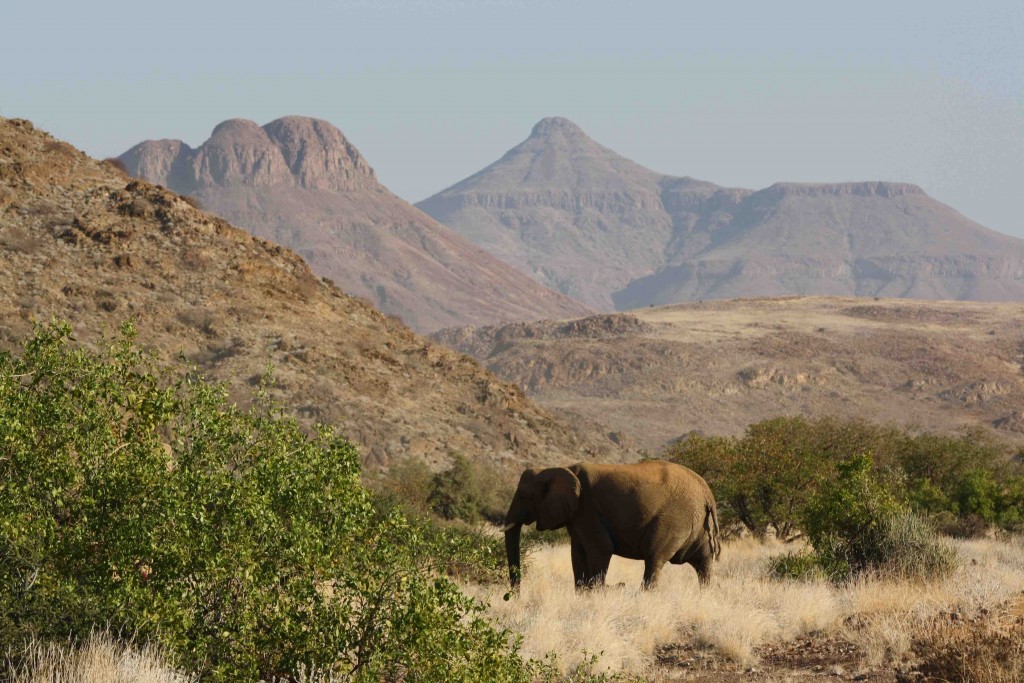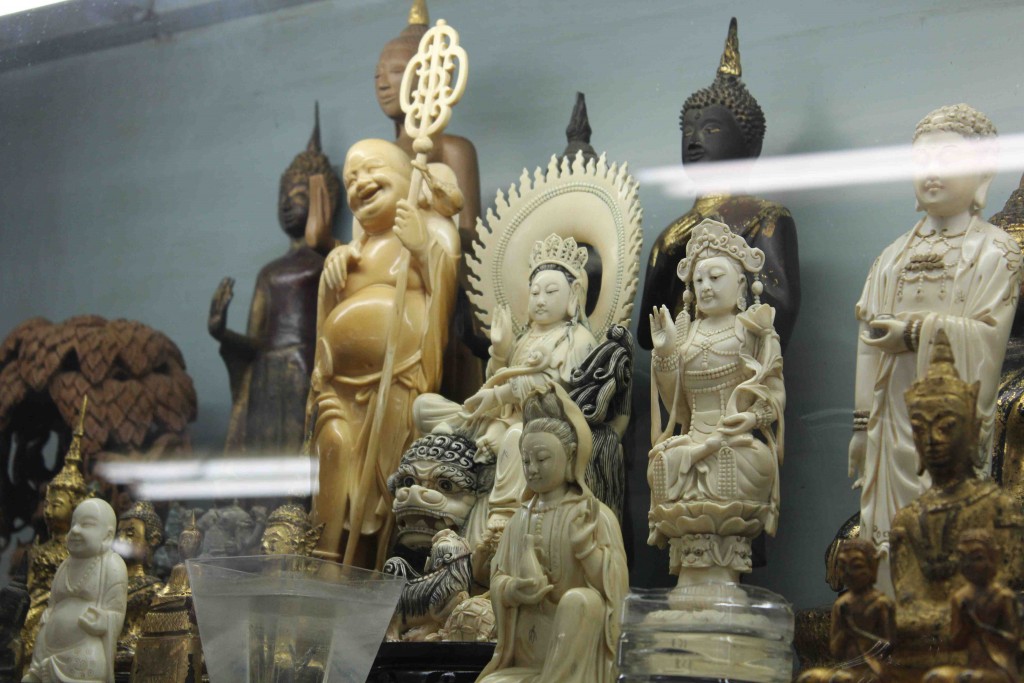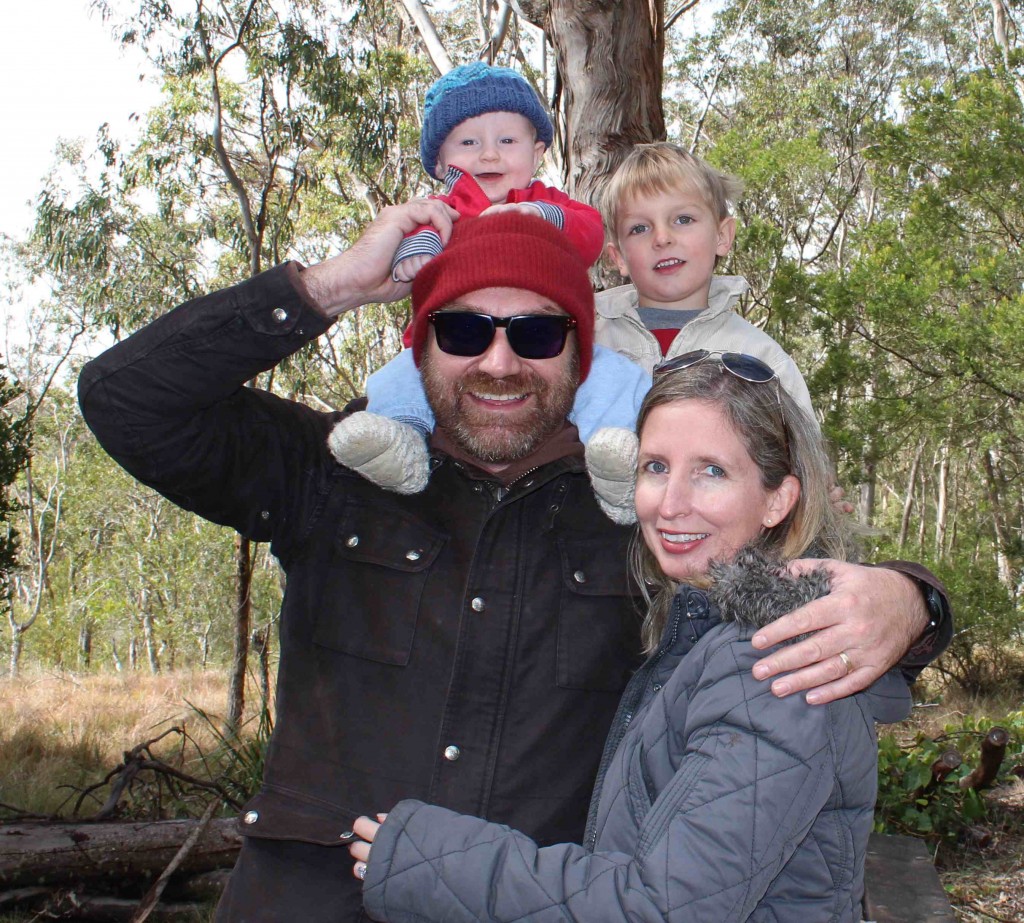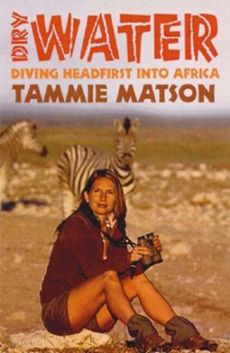Who’s Coming to the Skeleton Coast with Me?
Last year, Hoanib Skeleton Coast Camp won Tatler’s “Most Out Of This World” award. I reckon it would have been a tough choice for this between Hoanib Camp and Serra Cafema, two of the most remote and wild-feeling places you’re ever likely to visit, both of them run by Wilderness Safaris. That’s why my May 2016 safari focuses on these very two camps. Because I reckon they’re both awesome and, frankly, I want to go back there! I want you to feel the magic of Namibia’s wild spaces with me and go home feeling like you’ve just touched the moon. The truth is, in the modern world there’s not many places you can go where you are truly away from it all, hundreds of kilometres from civilisation and the things that own us (television, smart phones, meetings, commuting…). You won’t get a better escape than among the desert-dwelling animals and plants of Namibia’s North West region.
Right now I’m recruiting for my safari there in May next year (2016), which is already half full (up to a maximum of 12). Read on if you’d like to know more and get in touch with me here to sign up.

Can you see yourself here? (I can!) Serra Cafema Camp is set in the middle of the desert on the Kunene River
Namibia – Desert Dreaming Safari
If you’ve never experienced Namibia’s north west then you’ve got something special to look forward to! If you’ve ever dreamed of visiting the spectacular Skeleton Coast, meeting Namibia’s traditional Himba people, and spending time with desert dwelling elephants and lions in an environment that is wild, remote and pure adventure, then this is the safari for you.
Dates: 20- 27 May 2016
This luxury, conservation-focused safari kicks off on 20th May in Windhoek with a night at the Kalahari Sands Hotel, and then we’re off the next day by plane to Hoanib Skeleton Coast Camp for 3 nights. On our second day, we’ll do a full day fly-in excursion to the Skeleton Coast itself, where we’ll see shipwrecks, desert dunes, seals and so much more. I’ll spend time telling you about the behaviour and ecological functions of the elephants and other species in this unique, fragile region.
On 24th May, we’ll fly to Africa’s most remote and my favourite camp, Serra Cafema and spend 3 amazing nights there. I don’t know how to describe this luxurious camp – it’s so much more than an oasis in the desert. You just have to see it to believe it. A community partnership with the local Himba community is one of the unique features, meaning it really makes a meaningful contribution to the locals and hence to conservation. You’ll see how the Himbas live and breathe in landscapes so big you will feel like the tiniest of insects in this vast landscape. Serra Cafema camp also made the Top 50 in “Africa’s Finest” for its contribution to conservation.
Finally on 27th May, we’ll all fly back to Windhoek and bid farewell.
Price: SING$10,000/person sharing (approx AUD$9350 at current exchange rate on 3/3/15)
All meals and drinks are included in these safaris (with the one exception of the first night in Windhoek on the Namibian safari), all luxury accommodation, all park and community fees, two activities daily, internal flights between camps, laundry, and donations to relevant conservationists we spend time with. Travel insurance is compulsory and can be added separately. International flights to and from your home town are not included.

The local Himba people benefit from the community partnership with Wilderness Safaris that is Serra Cafema Camp
Remember that the price also contributes to local conservation projects and keeps the wildlife and traditional communities you meet along the way afloat – so it’s really as good as a donation to charity. You’re also keeping my conservation work going, as my safari company is what pays the bills and allows me to do my conservation work for free.
Group size is limited to 12 people and this trip is currently half full. Family groups are welcome. Please get in touch with me now if you’d like to sign up for this amazing adventure!
Elephant Round Up
We’ve seen some promising signs from China in the last week in relation to the ivory trade driving elephant poaching in Africa, with the Chinese government conducting their third ivory destruction in the last eighteen months and committing to phase out its legal, domestic ivory industry. No time line has yet been given, but it is encouraging to see the Chinese taking stronger measures and the steps have been lauded by conservation organisations.
So are attitudes changing? A survey by WildAid showed that 95% of Chinese supported a total ban on ivory sales. Another one by WildAid, the African Wildlife Foundation and Save The Elephants showed that three quarters of Hong Kong residents supported a ban on ivory sales there too. Hong Kong is a major transit point for ivory to Chinese market places.
The Let Elephants Be Elephants team participated in an awareness and fund raiser for elephants in Hong Kong in November last year, run by the Hong Kong Elephant Society. Our campaign has always been focused on South East Asia, but we are now starting to form some good working partnerships with organisations in Hong Kong as well.
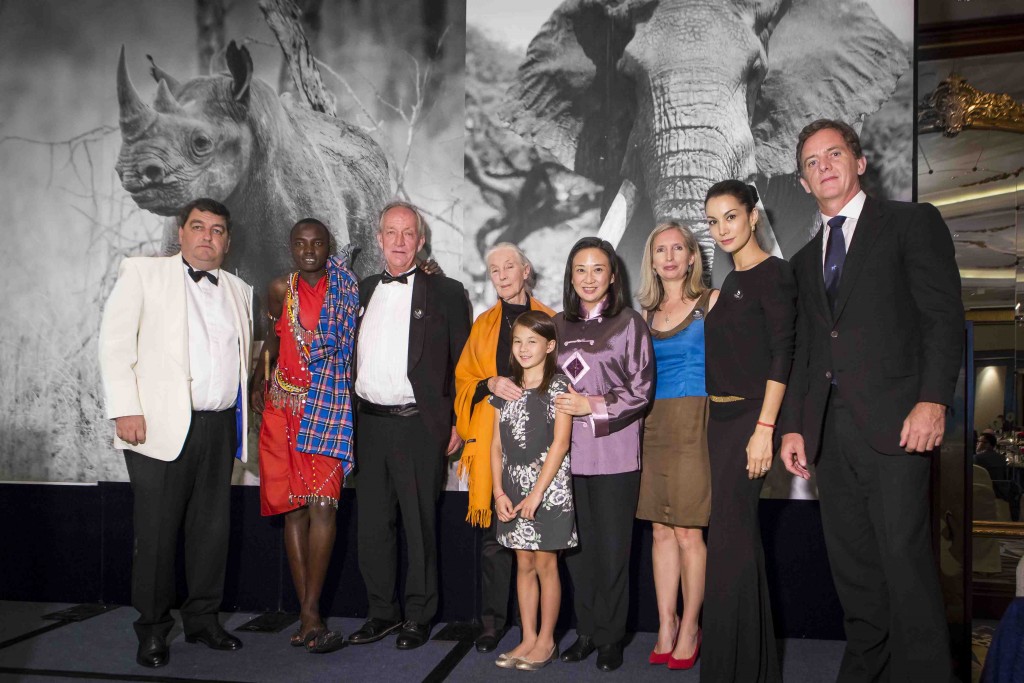
HK Elephant Society co-founder Colin Dawson, Maasai spokesperson John Tabula, Big Life’s Richard Bonham, Jane Goodall, one of the amazing kids who started the movement which led to HK’s first ivory crushing, pro-environment legislator Elizabeth Quat, the LEBE team (me and Nadya Hutagalung), HK Elephant Society co-founder Ted Hodgkinson.
Other organisations that participated on the night were the Big Life Foundation, David Sheldrick Wildlife Foundation and the Jane Goodall Foundation.
There were some great heroes of conservation in the room that night. In one of the most special moments of my career, I had the pleasure of meeting Dr Goodall (photo above), whose book “In The Shadow of Man” I read when I was dreaming of becoming a wildlife researcher back in the early 1990s. Richard Bonham, COO of Big Life, went on from our event in Hong Kong to London to accept Prince William’s Life Time Achievement Award for conservation, so we were in fine company! Also there in support of elephants were the pro-environment Hong Kong politician, Elizabeth Quat and Hong Kong For Elephants‘ campaigner Alex Hofford. The night raised significant funds for three organisations, including a donation to LEBE’s Thailand demand reduction campaign.
Following successful launches in Singapore, Hong Kong, the Philippines and Indonesia, the Let Elephants Be Elephants campaign is planning to focus on Thailand’s ivory market in the next phase of the campaign, and this year so far we’ve been working on bringing in funds and developing the partnerships to roll out the campaign.
We’re heartened by the fact that the Thai government has taken some strong measures towards controlling their ivory markets in the last year, including strengthening laws around ivory trade and clamping down on registration of ivory across the country. We don’t entirely know what this means yet for ivory markets and elephants. LEBE co-founder Nadya Hutagalung found fewer stalls selling ivory in Bangkok during her visit there earlier this year than last year during the filming of the LEBE documentary, which was encouraging, but may also suggest the sellers are uncertain of what the future holds. What we don’t know is whether ivory sales have simply gone underground, and how long existing measures will be enforced. The need for education to reduce demand for ivory remains as strong as ever.
So what’s happening in Africa? Well, the bad news this week has been the WCS report showing the devastating loss of half of Mozambique’s elephants in the last five years. In neighbouring Tanzania, new census figures have shown a decline of 60% of the nation’s elephants in the last five years. This is happening right now! In addition, in western and central Africa, the ivory war is as bloody as ever.
Thankfully there was some good news in amongst the bad this week in the elephant world. This week I was heartened to see a report by WCS from Uganda showing that their elephant population is on the rise, with more than 5000 across the country (still quite low numbers in the big scheme of things however). And don’t forget that in countries like Botswana, the country with the world’s largest elephant population, they are doing just fine. I saw a commentary just today suggesting that South Africa has ‘too many’ elephants, a term I used to hear a lot when I lived in southern Africa in the early 2000s, but not so much these days. Does South Africa have too many elephants or just too little land?
With some countries at threat of losing most or even all of their elephants in the next decade, and others with good, strong populations, we need to look at Africa’s elephant population as just that – Africa’s – rather than one or another country’s elephants, because the species roams across human-defined border as if they don’t exist. The good thing about this is that elephants can expand into new areas when they know they are safe, repopulating former ranges across borders, and that’s where the idea of Africa as a series of interconnected parks and communal conservancies gets interesting. This is already happening in several countries, with great results.
I guess my point this week is that it’s easy to get overwhelmed by all the stories out there about the ivory wars, but bear in mind that both Africa and Asia are big places and the situation is different everywhere. While we might be losing the ivory war in some countries, and we may well see localised extinctions of elephants in some parks and/or countries in the next decade, we’re starting to see improvements in others. So don’t lose hope.
Remember that if you love Africa and you love elephants, make your next safari an ethical one that ‘gives back’ to the local communities who live with elephants and ensure their survival. Drop me a line for more info on joining one of my conservation focused safaris that make a difference.
Africa in the Green Season – Two Special Deals!
One of the most common questions I get asked about Africa is “When is the best time to go?” The answer to this isn’t as simple as you might think, and anyone who’s experienced the complexity of Africa’s seasons will tell you exactly that.
Of course, there is a typical ‘safari season’ between June and October, which is when most people go, during the cooler dry months when there is limited rainfall, moderate temperatures, grasses are low, many shrubs (like the mopanes in southern Africa) drop their leaves, and consequently visibility for wildlife sightings is better. In East Africa, the safari season is when you’ve got the best chance of seeing the famous Great Wildebeest Migration. The disadvantage of going in the ‘prime time’ for safaris, between about June and October, is that you pay a premium for the experience, in some places almost twice the price of other times of year.
So when do the locals go on safari? Well, here’s the big secret. It’s often not peak season, but in the ‘green’ season, between about November and May. Personally it’s my favourite time of year and here’s why I reckon it’s worth considering.
1) Baby animal fiesta
When the rains finally come in Africa, nature responds with fresh green grass and this triggers a baby boom that will melt the heart of even the most hardened game ranger. Baby impalas, baby cheetahs, baby springboks, baby wildebeests, baby zebras…. It’s a very special time of year around Feb/Mar when many of the babies drop and I just love being there then to witness it.
2) Epic thunder storms
To me Africa’s always been a place where I feel truly alive. It’s hard to explain if you haven’t been there. But during a thunderstorm the energy of the place is even more amazing. There’s nothing like the smell of fresh rain on earth that hasn’t seen water in six months or so. The photography opportunities afforded by the striking cloud formations as a big storm comes in are a dream for photographers. Sure, you might get bogged in the mud the next day, but hey that’s part of the fun!
3) Won’t hurt your wallet as much
Another major advantage of travelling in the green season is that prices are much lower because it’s not peak season. Sometimes you can pay more than half the price of peak season in the most popular safari countries like Kenya and Botswana. So your money stretches further, which means you can stay in Africa longer!
My Green Season Safaris in 2016
I am leading two ethical safaris in 2016, the first to Kenya’s Maasai Mara in Feb/Mar and the second to Botswana’s Okavango Delta & Makgadigadi Pan in Oct/Nov, both limited to 10/12 people plus me (yep, you have your own personal zoologist all the way through and I will tell you everything you ever wanted to know about the mating behaviour of dung beetles and the like!). If you’d like to join one of these groups, let me know or contact me for more information.
Kenyan Maasai Mara Safari – Feb/Mar 2016
Day 1: Visit to Daphne Sheldrick’s elephant orphanage & overnight at Ole Serene Lodge, a luxury hotel in a game park in Nairobi
Days 2-4: 3 nights at Naibosho Camp, Maasai Mara, a unique community partnership in an astounding area for wildlife
Days 5-7: 3 nights at the Mara Houses, Maasai Mara, like living in your very own bush house in the wilderness
US$5250/person sharing – limited to 12 people (if we get more than 8 people I can reduce the price of this one further).
All inclusive price (all accommodation, meals, drinks etc), but excludes international flights.
This is exactly the same as my sold-out safari to Kenya this July (peak season), but with an extra night and for a lower price!
Botswana Okavango and Makgadigadi Safari – Oct/Nov 2016
Days 1-3: Arrive in Maun and fly to Pelo Camp, an eco-friendly oasis on a wildlife-rich island in the heart of the world heritage listed Okavango Delta. Activities include wildlife viewing by both mokoro (wooden dugout canoe) and open vehicle.
Days 4-7: Return flight to Maun & drive to Meno A Kwena Camp, home to the San Bushmen & overlooking the Boteti River. Includes cultural activities with the San Bushmen, the chance to see wild meerkats & a full day excursion & sleep-out at the Makgadigadi Pans National Park.
US$5,500/person sharing. Limited to 10 people plus me.
All inclusive price (all accommodation, meals, drinks etc), but excludes international flights.
Dates will be confirmed as numbers firm up, but I need to book these camps now before they sell out so drop me a line now if you’re interested!
10 Things You May Not Know About African Wild Dogs
Is there anything as cute as African wild dog puppies? It’s definitely one of the highlights of going on safari if you get to see Africa’s painted dogs tending to their youngsters a their den or on a hunt, especially given their rarity in the wild (there are thought to be only about 5000 or so left on the entire continent). But did you know that these unique carnivores need huge areas to survive, that they are ‘caring and sharing’ towards each other, and that their play with each other actually serves an important purpose?
Two impressive researchers, Dr Rosemary Groom, and Masters graduate Jess Watermeyer, of the African Wildlife Conservation Fund, get to study these highly endangered creatures in their day job in the Save Valley Conservancy, Zimbabwe. I asked Rosemary and Jess to share their insights into African wild dog ecology with us. Read on – it’s fascinating stuff!
Wild Dog Fact #1
The scientific name for the African Wild dog means “painted wolf” (combination of Latin and Greek). Wild dogs are not related to domestic dogs and cannot interbreed with them. They are a single species on a unique evolutionary lineage and if anything are more closely related to wolves than dogs.
Wild Dog Fact #2
No two wild dogs have the same markings, which makes them easily identifiable as individuals. When they are born, they lack the tan colouration but their white markings are clear and do not change as they grow up, so you can identify which adult was which 3 week old pup!
Wild Dog Fact #3
Wild dogs are found only at very low densities – on average 2 dogs per 100 square kilometres. This means that an area the size of Greater London, which is home to 7.5 million people, could only support one or two African wild dog packs. And Washington DC – home to c. 700,000 could support less than 4 wild dogs.
Wild Dog Fact #4
Wild dogs have a very caring social structure. Pups that are old enough to eat solid food are given priority at a kill, even over the dominant pair.
Wild Dog Fact #5
The dogs have a peculiar and rather playful ceremony that bonds them for a common purpose and initiates each hunt. They start circulating among the other pack members, vocalizing and touching until they get excited and are ready to hunt. This reaffirms the social status – affirms sub-ordinance and dominance which prevents the need for aggressive behaviour within a pack.
Wild Dog Fact #6
African wild dogs are obligate cooperative breeders. Usually only a single pair within the pack will breed and the rest of the pack will help them to raise the young (e.g. by feeding and also babysitting). They also hunt cooperatively.
Wild Dog Fact #7
Wild dogs often use termite mounds that have previously been excavated by aardvarks or porcupines as a den. The pups are born in the den and only emerge for the first time at 2-3 weeks of age.
Wild Dog Fact #8
Wild dogs do not bring back bones and chunks of meat to the den. Instead, when the pups are weaned, any adult returning from a successful hunt will regurgitate meat for the pups. This helps to prevent a smelly build up of old bones etc at the den which may attract lions or hyenas which can kill pups.
Wild Dog Fact #9
When feeding, they lack aggression towards each other and share the kill; even with members who may not have been involved in the actual hunt (this is unlike most other social carnivores). Wild dogs look after the weak and the sick in the pack and bring food back for them.
Wild Dog Fact #10
African wild dogs were once considered a pest and were shot in large numbers in parts of Africa including Zimbabwe. Fortunately the mind set has changed and the dogs are now valued as the unique and remarkable animals they are.
I don’t know about you, but I always think the more you get to know a species the more respect you have for it. It wasn’t that long ago that African wild dogs were considered vermin, being hunted out to near extinction. These days, they’re one of the most interesting species you can watch while in the African bush and a highly prized sight on safari. Here’s hoping you get to see one on your next African adventure!
If you’d like to support the extremely worthy work being done by the team at the African Wildlife Conservation Fund, please make a donation and help them keep up their important work to conserve this species. Click on their Donate page here.
5 Reasons To Visit Namibia, Land of Big Skies & Desert Dunes
Where should you go on safari in Africa? The choices seem bamboozling at first – Kenya, Tanzania, Zimbabwe, Botswana, South Africa… All are amazing and have their own unique angles and experiences, but I’m going to share a few reasons why I think you should consider one of my favourite safari destinations – Namibia. If my photos below don’t convince you, consider these five reasons why Namibia should be on your bucket list.
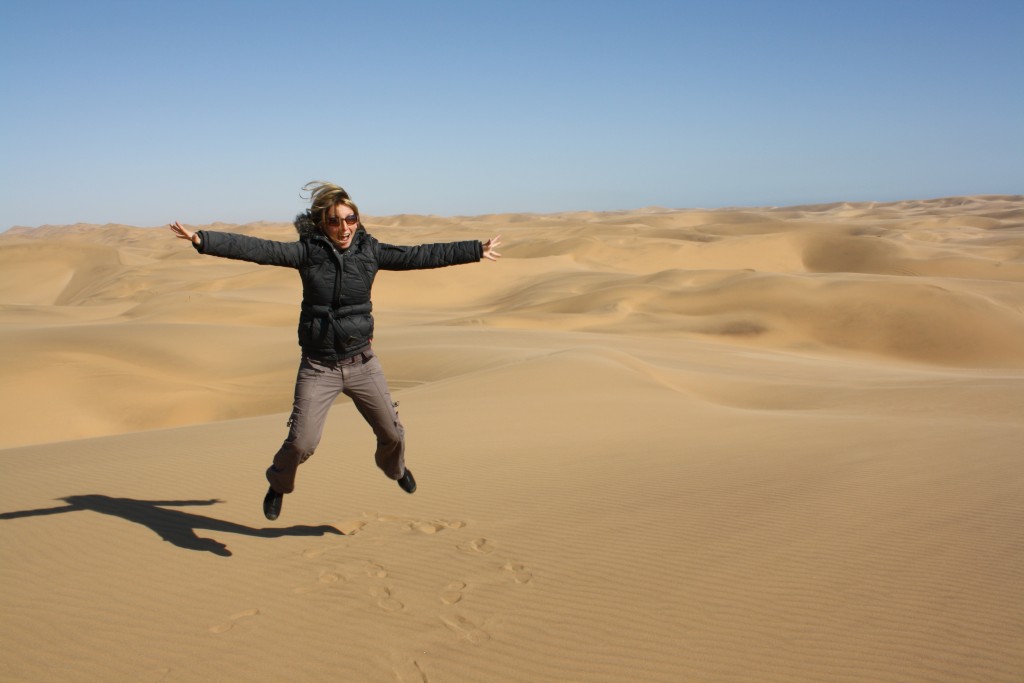
Don’t ask me why, but even if you’re not the kind of person who tends to do random jumps in the sky, Namibia’s vast sands will make you want to
1) Safety.
Namibia is one of the safest countries you can go on an African safari. A whole lot of people don’t realise that there are less safe countries to visit in Africa (Nigeria, Congo and parts of West Africa spring to mind) and there are much safer countries, like Namibia. In my opinion, the two safest places to travel in Africa are Namibia and Botswana, partly because of their low human populations, and secondly because you don’t get the same kind of crime that you get in some other countries (like South Africa). Namibia is fabulous for families and first timers to Africa. We always used to call it “Africa For Beginners”. Lots of people do self drive safaris there because the roads are good and the scenery is spectacular.
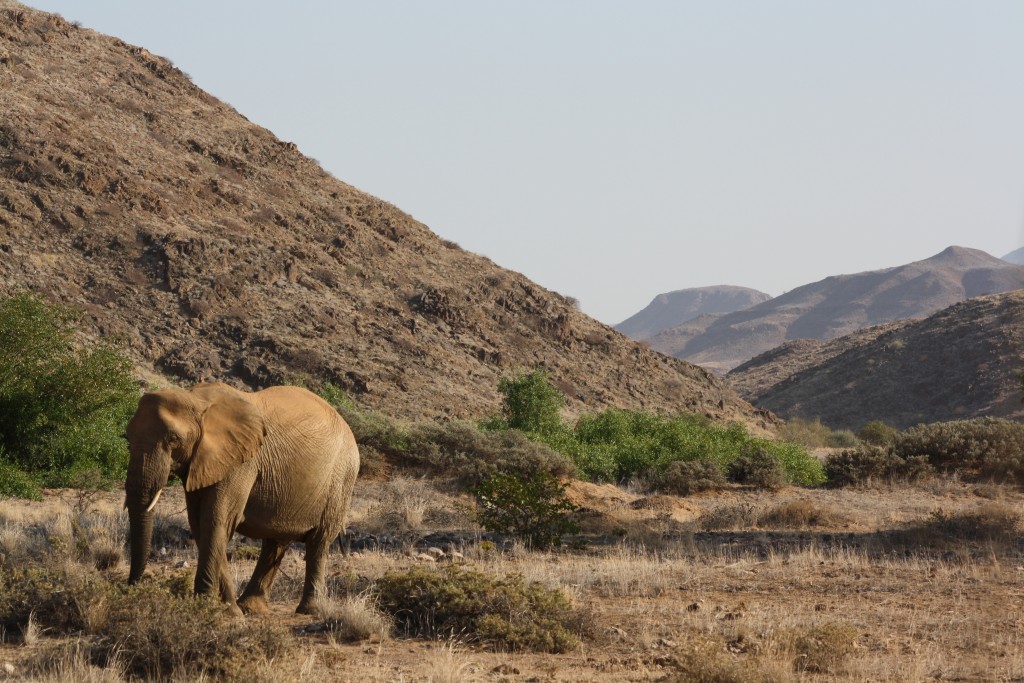
Desert elephants in Namibia. These are savannah elephants with special adaptations to life in the desert.
2) Space.
Most of us live in a world that is full of people living in close proximity to each other. We are constantly bombarded with commercialism and consumerism, bright lights, loud noises, all those things that are part of capitalistic life in the modern world. Namibia’s desert is the opposite of all that. There’s something about being miles from anyone else, enveloped by vast spaces and enormous skies, that provides a unique kind of escapism. For me, it’s a place I can breathe.
3) Conservation.
More than half of Namibia is under conservation protection. I mean, think about that. It’s amazing. Australia’s only got about 12% under protection. It’s not all national parks in that 50%+ under protection in Namibia, although at almost 20% in national parks that’s a big chunk too. The key is all the communal conservancies managed and legally run by the local ethnic groups. Namibia is one of the finest examples of community-based conservation you’ll find on the planet and tourism is a big part of that success story. In Namibia they’ve really got their head around giving local communities benefits from the wildlife, and that translates back to their excellent conservation record. If you book an ethical safari through Matson & Ridley Safaris, you’re directly contributing to this conservation success. Read more about Namibia’s community-based conservation at the website of the Namibia Nature Foundation.
4) Unique wildlife
The safari experience you get in Namibia is like no other. You won’t get all of the ‘Big Five’ (lion, leopard, buffalo, elephant, rhino) on your first game drive. Namibia’s about quality, not quantity. What you will get is a single, regal, solitary oryx antelope standing on the desert dunes at sunset. You’ll get tall, white elephants in Etosha (in the dry season), coloured that way because of the white dust flung off the enormous pan. You’ll get tiny lizards that dance to stop their feet overheating on the boiling hot sand, and desert beetles with tiny ridges on their backs that trap the moisture from fog rolling in from the coast by standing into the wind on a ridge of sand. What you get there is unique desert-adapted wildlife in huge landscapes that even dwarf elephants.
5) Variety
On a single safari, you can experience the sandy orange dunes in the Namib Desert, the red, rocky volcanic landscapes of Damaraland in the north west, thorny bush lands and of course the famous Etosha salt pan fringed by short grasslands. In the north east you get big flowing rivers and in Bushmanland you get ancient, towering baobab trees. It’s incredibly diverse. You do have to cover a bit of distance as it’s a big country, but your money goes a long way in Namibia. There are also at least 11 ethnic groups in Namibia, from the traditional ovaHimba people to the cattle-focused Hereros and the San Bushmen.
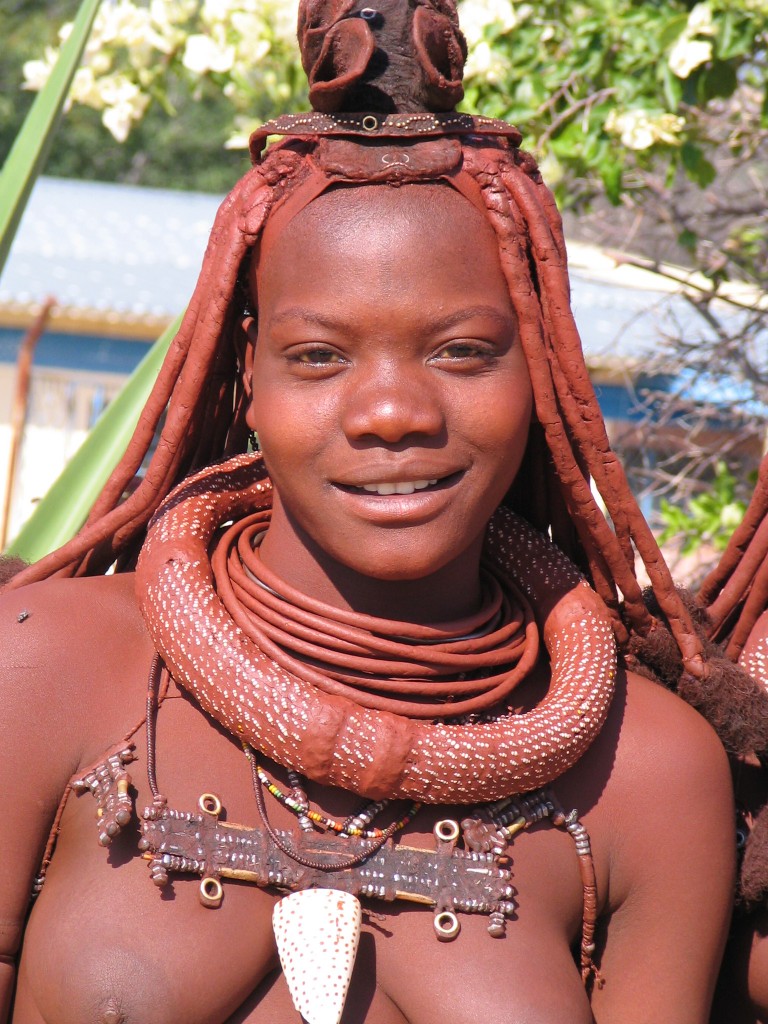
Meeting the local people while on safari is always a highlight, especially in areas where they benefit from the dollars you’re paying to visit them
I’ve got a few places left on my north west Namibia safari in May 2016, and only 1 spot for a single male for this year’s Namibian safari in September, so get in touch if you’d like to experience this amazing part of Africa with me. Alternatively, drop me a line if you’d like to book your own self-drive or fly-in safari in Namibia and I’ll plan an itinerary for you and your family that gives you your dream safari while making a difference in conservation. Namibia’s worth it, trust me!
Fancy a real wildlife adventure?
This week I thought I’d share a few videos of the great work being done in the Save Valley Conservancy, Zimbabwe to conserve wildlife, the location of one of only two conservation safaris I’ll be leading in 2016. (Click on this link for details)
This 8 minute preview to the upcoming documentary “Ranger Danger” by Reel Life Productions shows the work of the specialist rhino anti-poaching team in the Save Valley Conservancy, Zimbabwe. The short film takes you behind the scenes in the daily battle to save Africa’s rhinos. Featuring insights from Bryce Clemence and his anti-poaching rangers, scenes of a wild dog being de-snared, as well as a re-enactment of an encounter with poachers (seemed real enough to me – trust me, you feel the adrenaline!).
On my safari to Zimbabwe in July next year, as well as spending time tracking rhinos with Bryce’s team, we’ll also be hanging out with the team working to conserve African wild dogs, Dr Rosemary Groom and Jess Watermeyer, and for some pure magic, spending time at a wild dog den while there are puppies! You’ll get to hear about African wild dog behaviour directly from the experts. Check out the video below to see the research team removing a snare set by poachers from an endangered wild dog. Wild dogs are highly social and quite playful with each other. Stay tuned for a future blog all about them…
And last but not least, we’ll spend a morning on my safari with Karen Paolillo, ‘the hippo lady’ at Turgwe Hippo Trust, who has been in the area for over two decades, observing up close and personal the hippos and their behaviour in the Turgwe River, and Karen’s special relationship with them. I don’t think there’s anyone in the world who knows wild hippos as well as Karen does, and visiting her is a truly special experience. Karen’s home, “Hippo Haven”, attracts all sorts of animals, including baboons, vervet monkeys and warthogs.
To spend time with the awesome rangers fighting for Zimbabwe’s rhinos, as well as Rosemary Groom’s wild dog team and Karen Paolillo and the Turgwe hippos, join my conservation safari to Zimbabwe in July next year. A portion of what you pay to go on this safari goes directly to the projects we’ll be visiting. Click here for more information. Don’t wait to add your name to the list as I am booking this safari now due to the popularity of the camps, which book out a year in advance. Experience the passion and the adventure of Africa with me while contributing to important conservation work – this is a safari that really makes a difference!
The World of Hyaenas
I’m a massive fan of hyaenas. They’re comical, cheeky and downright cute if you look at them from the right angle. One person who agrees with me is Dr Martina Trinkel, who was studying spotted hyaenas in Etosha National Park when I was studying black-faced impalas for my PhD many years ago. We both lived at the research camp at Okaukeujo, but for my first six months I barely knew her, as being a researcher of a nocturnal predator, she would go out at sunset to look for hyaenas just as I was coming back for a good night sleep after a day of studying impalas. I would see her return home in the early hours of the morning, just as I was heading out. You’ve got to be dedicated to be a predator researcher, out all night in the desert cold, patiently seeking elusive animals in the dark, but as this interview with Martina shows, she developed a huge respect for the hyaenas we all know and love from ‘The Lion King’.
Join Author Sally Henderson in Botswana
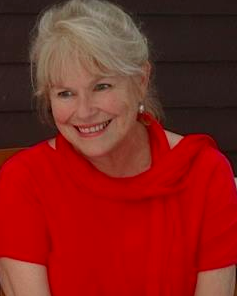 Author Sally Henderson and I have been good friends since long before either of us ever knew we would be published authors. Like me, Sally loves Africa with a passion, and so I’m very excited to offer you the exclusive opportunity to travel to Africa with Sally during Botswana’s amazing green season this year!
Author Sally Henderson and I have been good friends since long before either of us ever knew we would be published authors. Like me, Sally loves Africa with a passion, and so I’m very excited to offer you the exclusive opportunity to travel to Africa with Sally during Botswana’s amazing green season this year!
Sally’s love affair with Africa and its elephants came to life in “Silent Footsteps” and in its sequel, “Ivory Moon”. Join this thoughtfully planned safari and you will experience that passion for yourself as Sally shares her unique perspective of the wilderness and its creatures. You might even learn a thing or two about writing along the way.
A one-off journey that makes a difference to local wildlife and people, the safari incudes the Kalahari Desert, the World Heritage listed Okavango Delta, the Chobe river ecosystem and the majestic Victoria Falls, a truly unforgettable exploration into untamed Africa among an intimate group of like-minded travellers. Traveling in the safety and comfort afforded by one of Africa’s top ecotourism operators, Wilderness Safaris, in partnership with Matson & Ridley Safaris, you will be taken care of every step of the way and can trust that a significant portion of what you pay to go on this safari benefits local people and wildlife.
In the green season you can expect awe-inspiring thunderstorms and sunsets, lots of baby animals and warm summer days and without the crowds and price tag of the dry winter months (check out my recent photos taken in Botswana’s green season last year – click here). Don’t miss this exciting opportunity to join Sally Henderson’s intimate adventure into the Okavango Delta for 9 nights in November this year. This intimate safari is limited to 8 people sharing so contact me now to sign up.
Sunday 29th November – Kalahari Plains Camp
Set in a remote part of the diverse and productive Central Kalahari Game Reserve, this camp offers some of the best summer wildlife viewing opportunities in Africa. Located in the largest conservation area in Botswana, its star attractions include the legendary Kalahari black-maned lion and excellent cheetah viewing. The camp itself overlooks an immense pan with endless horizons and beautiful skies. The main area has a lounge and dining area with a swimming pool and deck. Solar power provides all the electricity and hot water in camp and insulated canvas walls and roof keep temperatures inside the units comfortable. One of the unique experiences at this camp is the interpretive ‘Bushman walk’ where you can immerse yourself in the culture of the Kalahari San.
Tuesday 1st Dec 2015 – Gomoti Tented Camp, Botswana
Gomoti Tented Camp lies in the centre of the private 6 000-hectare Santawani Concession, in the south-east corner of the Okavango Delta. The camp is nestled under large acacia trees in a diverse game-rich area. Most of the concession area comprises a mixed woodland habitat that gives way to open grasslands which can transform into floodplains in years of plentiful water. The area is rich with the wildlife for which the Okavango Delta is famous, including elephants, lions, African wild dogs, cheetahs and leopards.
Friday 4 Dec 2015 – Linyanti Discoverer Camp, Botswana
Set in the 125 000-hectare Linyanti Concession bordering Chobe National Park, Linyanti Discoverer Camp is your base from which to explore this enormous wildlife-rich area. Unrivalled in its remoteness and space, the concession is bisected by an ancient watercourse – the now-flowing Savute Channel. Wildlife is abundant and includes the seldom-seen sitatunga that can be spotted in the waterways, as well as the rare sable antelope.
Mon 7 Dec 2015 –Toka Leya Camp, Zambia
Overlooking the mighty Zambezi River and some of its islands, Toka Leya Camp is siutated in the Mosi-oa-Tunya National Park. The camp’s dining, lounge and bar areas offer ample space for relaxation and are complemented by an infinity pool, with meals served on the sundeck, the pool deck and dining room all overlooking the Zambezi. Situated just 12 kilometres from the world-renowned Victoria Falls, hippo, crocodile and elephant are regularly seen in or near camp. On the way to Toka Leya Camp you will experience a Chobe River boat cruise, and the opportunity to see elephants and hippos from this magnificent wildlife-rich waterway.
Inclusions on the Safari
- All accommodation as specified in the itinerary
- All meals (three course dinners), including the lodge/hotel in Livingstone
- All soft drinks, beer, fruit juice, mineral water and house wine, as well as small selection of local liquors
- Activities, guided tour of the Victoria Falls as specified in the brief itinerary
- Seat-in-plane light aircraft transfers (including departure taxes where applicable) as specified in the brief information
- Limited laundry is available ,all smalls to be done by guests
Exclusions on the Safari
- International flights
- Visas
- All relevant entry and departure government stipulated fees/taxes and unexpected increases thereto
- All personal purchases, including curios, premium brand liquors, telephone calls, etc.
- Any pre- and/or -post tour arrangements
- Optional extra activities/services not included in the brief itinerary
- All flights (other than specified)
- Gratuities
COST PER PERSON SHARING USD$8500
COST PER SINGLE PERSON USD$9500
MAXIMUM GROUP SIZE OF 8 PEOPLE SHARING PLUS SALLY
Contact me now to sign up!
Elephants, Safaris & More
First of all, just a quick reminder to book your spots on my 2016 safaris to Namibia and Zimbabwe if you haven’t already. I have very limited spots on these safaris, and they need to be booked a year in advance. For all the details of both safaris, please click here. Both are safaris that really make a difference in conservation and community development. In the Zimbabwean conservation safari in July 2016, you get to track rhinos with the pros, hang out with wild dog and hippos conservationists, and experience the amazing Hwange National Park, known for its large elephant concentrations & much more, and Victoria Falls. In the Namibian conservation safari, we’ll be visiting the north west of the country, focusing on the Skeleton Coast, spending time with desert elephants and the traditional Himba people. I can tell you from personal experience, both trips are mind blowing and life changing and the camps are as good as you’ll get in Africa!
Secondly, you may have heard that both China and Thailand are making some progress on clamping down on the illegal ivory trade. We’ve seen Thailand enforce a new law, the Elephant Ivory Act, which requires that all ivory be registered by the authorities by 21 April 2015 or face a penalty of 3 years in prison and/or a large fine. Some media sources are reporting that as a result the number of ivory traders has dropped markedly, as so many of them were unable to verify the origin of their ivory. I haven’t been able to independently verify this myself, and I believe there continues to be a major need for demand reduction in this country. Thailand has also instigated forensic technology to identify the source of ivory (Asian vs African) and will help police the trade.
China recently banned ivory carvings for a year, around the time of Prince William’s visit to Beijing, however this represents only a small amount of the ivory in circulation, and it’s really nowhere near enough to stop the problem. There’s a good article on this if you’re interested in learning more – click here. Prince William has become an outstanding advocate for stopping the demand for ivory and rhino horn and continues to speak out and use his influence for the cause. Check out his speech given recently in China by clicking here. But it’s going to take a lot more than is currently being done to reduce demand in China, the country most heavily driving the illegal ivory trade.
I’ve been working hard with the Let Elephants Be Elephants team this year to focus our awareness-raising efforts on Thailand this year – so watch this space for more information, coming up soon!
Finally, after a few lovely months back on home turf in Queensland, Australia, our family is relocating again, this time to Amsterdam in the Netherlands where my husband Andy is taking up an exciting new job in the environment movement. I’ll continue to update you on all things elephants and African safaris from my new base there.
My 2016 safaris – Zimbabwe & Namibia’s North West
As part of my travel agency, Matson & Ridley Safaris, I will be leading two safaris to two of my favourite parts of Africa in 2016. Based on my past safaris, the very limited spaces (maximum 12 people) book out very fast, so if you’d like to join please drop me a line now! These camps have to be booked now because they are so popular they book out a year in advance or more. And as with all my safaris, the camps are selected by me to ensure your tourism dollars make a difference on the ground. Trust me, these safaris will change your life! (more…)

